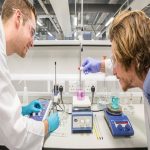The chemical engineering profession evolved from the industrial applications of chemistry and separation science (the study of separating components from mixtures), primarily in the refining and chemical industry, which we will refer to here as the chemical process industries (CPI). The first high-volume chemical process was implemented in 1823 in England for the production of soda ash, which was used for the production of glass and soap. During the same time, advances in organic chemistry led to the development of chemical processes for producing synthetic dyes from coal for textiles, starting in the 1850s. In the latter half of the 1800s a number of chemical processes were implemented industrially, primarily in Britain. And in 1887 a series of lectures on chemical engineering which summarized industrial practice in the chemical industry was presented in Britain. These lectures stimulated interest in the United States and to some degree led to the formation of the first chemical engineering curriculum at MIT in 1888. Over the next 10 to 15 years a number of U.S. universities embraced the field of chemical engineering by offering fields of study in this area. In 1908, the American Institute of Chemical Engineers was formed and since then has served to promote and represent the interests of the chemical engineering community.
Mechanical engineers understood the mechanical aspects of process operations, including fluid flow and heat transfer, but they did not have a background in chemistry. On the other hand, chemists understood chemistry and its ramifications but lacked the process skills. In addition, neither mechanical engineers nor chemists had backgrounds in separation science, which is critically important to the CPI. In the United States, a few chemistry departments were training process engineers by offering degrees in industrial chemistry, and these served as models for other departments as the demand for process engineers in the CPI began to increase. As industrial chemistry programs grew, they eventually formed separate degree-granting programs as the chemical engineering departments of today.
The acceptance of the “horseless carriage,” which began commercial production in the 1890s, created a demand for gasoline, which ultimately fueled exploration for oil. In 1901, a Texas geologist and a mining engineer led a drilling operation (the drillers were later to be known as “wildcatters”) that brought in the Spindletop Well just south of Beaumont, Texas. At the time, Spindletop produced more oil than all of the other oil wells in the United States. Moreover, a whole generation of wildcatters was born, resulting in a dramatic increase in the domestic production of crude oil, which created a need for larger-scale, more modern approaches to crude refining. As a result, a market developed for engineers who could assist in the design and operation of processing plants for the CPI.
The success of oil exploration was to some degree driven by the demand for gasoline for the automobile industry, but ultimately the success of the oil exploration and refining industries led to the widespread availability of automobiles to the general population because of the resulting lower cost of gasoline.
These early industrial chemists/chemical engineers had few analytical tools available to them and largely depended upon their physical intuition to perform their jobs as process engineers. Slide rules were used to perform calculations, and by the 1930s and 1940s a number of nomographs were developed to assist them in the design and operation analysis of processes for the CPI. Nomographs are charts that provide a concise and convenient means to represent physical property data (e.g., boiling point temperatures or heat of vaporization) and can also be used to provide simplified solutions of complex equations (e.g., pressure drop for flow in a pipe). The computing resources that became available in the 1960s were the beginnings of the computer-based technology that is commonplace today. For example, since the 1970s computer-aided design (CAD) packages have allowed engineers to design complete processes by specifying only a minimum amount of information; all the tedious and repetitive calculations are done by the computer in an extremely short period of time, allowing the design engineer to focus on the task of developing the best possible process design.
During the period 1960 to1980, the CPI also made the transition from an industry based on innovation, in which the profitability of a company depended to a large degree on developing new products and new processing approaches, to a more mature commodity industry, in which the financial success of a company depended on making products using established technology more efficiently, resulting in less expensive products.
Globalization of the CPI markets began in the mid-1980s and led to increased competition. At the same time, developments in computer hardware made it possible to apply process automation (advanced process control, or APC, and optimization) more easily and reliably than ever before. These automation projects provided improved product quality while increasing production rates and overall production efficiency with relatively little capital investment. Because of these economic advantages, APC became widely accepted by industry over the next 15 years and remains an important factor for most companies in the CPI.


